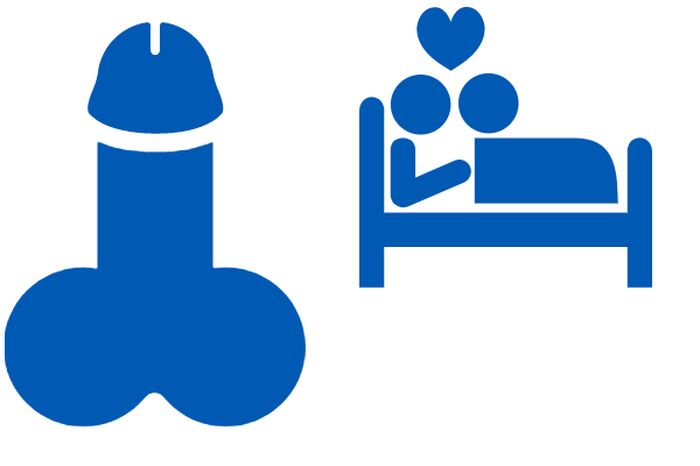Male Infertility - The causes, exams and medical and natural treatments
Are men today less fertile than in the past? Over the last fifty years, statistics have shown that the level of fertility and reproductive capacity among men has decreased.

The most prominent aspects of low fertility observed by researchers are:
- Low sperm count;
- Decreased movement (motility) and vitality of sperm;
- Increased number of abnormal sperm.
One of the most important reasons that researchers see behind the occurrence of this problem is environmental pollution, which has become an alarming concern. This pollution is attributed to all types of toxins, harmful residues, chemicals that we are exposed to, which negatively affect the process of sperm formation in the testicles.
In addition to environmental factors, other causes of infertility include:
- The presence of a structural, congenital or genetic defect that prevents the formation of healthy sperm;
- Failure of the testicles to descend into the scrotum;
- Infection that affects the sperm production process, such as mumps;
- Testicular injury;
- Immune imbalance that generates antibodies against sperm;
- Use of anabolic steroids;
- Excessive smoking;
- Drug use;
- Frequent exposure to high-grade radiation;
- Not being able to ejaculate, either due to damage to specific nerves or erectile dysfunction, among others.
The relationship between testosterone and infertility
The relationship between the male hormone testosterone and infertility is something that deserves attention, as it can often be perfectly avoided.
Having normal testosterone levels is important for men's health. Hormone production gradually drops with age, remaining within expected normal parameters. However, under certain conditions, low testosterone levels can affect male fertility. For some men, their doctor may recommend hormone replacement therapy to improve symptoms related to low testosterone.
On the other hand, excessive use of anabolic steroids, which are derivatives of this hormone, can cause a series of imbalances in the body, including being the cause of infertility for some.
Today, many of the men and women who use anabolic steroids are athletes, bodybuilders and young people who go to the gym and seek to improve their performance and physical appearance. In other words, they seek the anabolic effect of steroids, specifically increasing muscle tissue and reducing body fat. But excessive abuse of these substances without any medical supervision can have health consequences, including being the cause of infertility.
The formation of sperm, a process known as spermatogenesis, is regulated by the natural production of testosterone in the testicles.
This means that, when there is high sperm production, testosterone sends a signal to the brain and the synthesis of LH and FSH is blocked, hormones that are secreted by the pituitary gland and responsible for stimulating spermatogenesis.
However, when increasing the concentration of testosterone in the blood with anabolic steroid injections, there is a continuous blockage of sperm production, leading to azoospermia, which means the absence of sperm in the ejaculate.
The body cannot distinguish whether the origin of the hormone testosterone is natural or artificial, so the formation of sperm in the testicles is interrupted, causing sterility.
In addition, as sperm generation ceases, the testicles become smaller, since the majority of the testicular volume corresponds to the seminiferous tubules where spermatogenesis occurs.
This hormonal change can be reversed after eliminating the external supply of anabolic steroids, but it will take a minimum of three months to restore testicular function.
In summary, having low testosterone levels decreases fertility, but high levels are also harmful. Therefore, the solution lies in hormonal balance and monitoring with a qualified professional.
The decline in fertility at age 40
As men age, their testicles are subject to age-related structural changes, such as narrowing of the seminiferous tubules, along with morphological changes, including a reduction in the number of germ cells.
Total and free testosterone levels decrease with age as dysfunctional testicular activity increases.
Still, andReactive oxygen species begin to accumulate in the male germ cell with aging, causing damage to sperm DNA and oxidative stress.
A meta-analysis of 90 studies examining the effect of age on male fertility found an age-related decrease in total semen volume, total sperm number, typical sperm morphology and motility, and an increase in DNA fragmentation .
After an analysis of semen parameters in healthy men aged between 22 and 80 years, it was demonstrated that sperm motility and semen volume gradually decreased over time, but without a specific age limit.< /p>
However, similar research involving retrospective analysis of semen parameters in 5,081 men aged between 16.5 and 72.3 found the following:
- The number of motile sperm and their total count decreased after 34 years;
- The number of sperm with typical morphology and concentration decreased after 40 years;
- Sperm motility decreased after 43 years;
- The volume of ejaculate produced decreased after 45 years;
- The proportion of sperm carrying Y:X decreased in ejaculate after 55 years.
Consistent with this, the study researchers observed that regardless of the woman's age, the chance of conception decreases in men over 34 years of age.
The underlying mechanisms of the age-related decline in male fertility are not well understood. It is assumed that such changes may be due to increased risk of damage to the reproductive system resulting from infections or smoking, tissue reduction and damage to cellular repair due to exposure to toxins or disease, or due to normal changes occurring within the reproductive system as individuals age.
Exams carried out to investigate male infertility
If the man notices any change in the ejaculatory fluid, such as a decrease in ejaculate volume or even the absence of ejaculation, difficulty maintaining an erection or having children; the individual should seek out a urologist, who is a specialist in male infertility.
To diagnose infertility problems, the following tests can be done:
1. General physical examination and medical history:
Includes an examination of the genitals and questions about hereditary conditions, chronic health problems, illnesses, injuries or surgeries that can affect fertility. Your doctor may ask about sexual habits and sexual development during puberty.
2. Semen analysis:
Semen samples can be obtained in two different ways. The man can provide a semen sample obtained by masturbating and ejaculating in a special container at the doctor's office. Or it can be collected by using a special condom during sexual intercourse.
The semen is then sent to a laboratory to count the number of sperm present and look for any abnormalities in sperm shape and motility. The lab will also test the semen for signs of problems, such as infections.
Often, sperm counts vary significantly from one sample to another. In most cases, multiple semen analyzes are performed within a certain period to ensure accurate results.
3. Scrotal ultrasound:
This test uses high-frequency sound waves to produce images of the inside of the body. Using a scrotal ultrasound, your doctor can see if there is a varicocele or other problems with the testicles.
4. Transrectal ultrasound:
A small lubricated rod is inserted into the rectum. This allows the doctor to examine the prostate and see if there are any blockages in the channels that carry semen.
5. Hormonal analysis:
Hormones produced by the pituitary gland, hypothalamus and testicles play a fundamental role in sexual development and sperm production. Abnormalities in other hormonal systems can also contribute to infertility. A blood test measures the level of testosterone and other hormones.
6. Urine test after ejaculation:
Semen in urine may indicate that sperm is released into the bladder instead of exiting the penis during ejaculation, called retrograde ejaculation.
7. Genetic test:
A very low sperm count may be due to a genetic cause. A blood test can reveal whether there are subtle changes to the Y chromosome (signs of a genetic abnormality). Genetic testing may be ordered to diagnose a variety of hereditary or congenital syndromes.
8. Testicular biopsy:
This test involves taking samples from a testicle with a needle. If testicular biopsy results show that testicular productionsperm is normal, it is likely that the problem is due to a blockage or other problem related to semen transport.
9. Specialized analyzes of seminal function:
Several tests can be used to analyze sperm's ability to survive after ejaculation and ability to penetrate an egg. This test is not used frequently and generally does not significantly change treatment recommendations.
Treatments that can be recommended
Treatments for male infertility depend largely on the cause. The most recommended include:
1. Surgery:
For example, with surgery, it is often possible to correct a varicocele (abnormal dilation of the testicular veins) or repair a blocked vas deferens. Previous vasectomies can be reversed. In cases where there are no sperm present in the ejaculate, sperm can usually be recovered directly from the testicles or epididymis.
2. Treatment of infections:
Antibiotic treatment can cure a reproductive tract infection, but does not always restore fertility.
3. Treatments for problems in sexual relations:
Medication or counseling can help improve fertility for conditions such as erectile dysfunction or premature ejaculation.
4. Hormonal treatments and medications:
Your doctor may recommend hormone replacement therapy or medications for infertility caused by high or low levels of certain hormones, or problems with the way your body uses them.
5. Assisted reproduction techniques:
Assisted reproduction techniques consist of obtaining sperm through normal ejaculation, surgical removal or individual donors, according to the specific case and the individual's preferences. The sperm is then inserted into the female genital tract or used for in vitro fertilization or intracytoplasmic sperm injection.
How to increase male fertility naturally?
Health must be seen as something integral, where details count. And to help boost male fertility, check out the tips that can help improve health, bring a better quality of life, and also help improve sperm:
Stop smoking
Quitting smoking is one of the most important aspects. This is because smoking can lead to the production of a smaller number of sperm with low motility, in addition to an increase in the production of abnormal sperm.
After a period of three months - which is the time for sperm formation - since quitting smoking, sperm gradually return to their normal state and thus contribute to fertility.
Continuing to smoke when you have a child can expose the newborn to frequent respiratory problems, such as bronchial asthma, as well as increasing their susceptibility to colds and bronchitis.
Get adequate and balanced nutrition
The lack of certain vitamins and minerals, such as zinc, vitamin B12 and vitamin E, affects the sperm production process, which reflects the importance of a healthy, nutrient-balanced diet. To do this, include fruits, fresh vegetables, legumes and legumes in your diet, but avoid fatty foods, foods with a lot of sugar or sodium.
Practice physical exercise regularly
Regular exercise ensures physical fitness and increases the vitality of the body, and this makes the spouses more prepared for the process of procreation and subsequently helps the wife to bear the challenges of pregnancy to a greater extent as compared to others people who lack adequate physical fitness.
Avoid drugs
Just as sperm are harmed by the harmful effects of smoking, the damage inflicted on them is also great if a man consumes narcotics or intoxicating substances of various types.
These toxins lead to a decrease in sperm and a weakening of their vitality, as well as an increase in the percentage of defective sperm.
Keep the testicles cool
You might be surprised by this unusual advice. But anything that increases the temperature of the testicles affects the sperm production process. If you are preparing to have a baby, avoid very hot water, tight underwear, especially those made from synthetic fibers. Instead, wear comfortable, cotton clothing.
Be aware of these dangers
Exposure to radiation or some chemicals can reduce the degree of fertility, as this leads to damage in the spermatogenesis process.
Care should be taken with repeated exposure to electromagnetic radiation, which has become frequent around us. There is a study that indicates its danger to men's fertility, where the sources of this radiation are power stations, microwaves and cell phones in your pants pocket.(It has not yet been conclusively proven that phones affect men's fertility).
Use anabolic steroids only under medical supervision
Anabolic steroids have their benefits and harms. Using them in a supervised manner and without exaggeration is ideal for preserving fertility.
Vitamin B12 to increase fertility: a new discovery
The latest discovery about B vitamins, especially B12, and their relationship with fertility is that vitamin B12 stimulates the production of better quality sperm, which can cure infertility in some cases.
p>The medical journal “The Lancet” mentioned in an article that some doctors were able to treat male infertility by giving high doses of vitamin B12 by injection to patients, as this therapeutic regimen led to an increase in sperm maturity.
Vitamin B12 is also used as a treatment for female infertility caused by pernicious anemia, where a deficiency of this vitamin is present.
Some doctors believe that, in cases of infertility or sterility, the level of vitamin B12 in the blood should be measured. If a deficiency is proven, the vitamin should be administered to help overcome the problem.
References:
- Henriques, Magda Carvalho, et al. "The Role of Endocrine-Disrupting Chemicals in Male Fertility Decline." Male Reproductive Health. IntechOpen, 2019.
- Hassan, Mohamed AM, and Stephen R. Killick. "Effect of male age on fertility: evidence for the decline in male fertility with increasing age." Fertility and sterility 79 (2003): 1520-1527.
- Durairajanayagam, Damayanthi. "Lifestyle causes of male infertility." Arab journal of urology 16.1 (2018): 10-20.
- Evans, Nick A. "Current concepts in anabolic-androgenic steroids." The American journal of sports medicine 32.2 (2004): 534-542.
- Shahidi, Nasrollah T. "A review of the chemistry, biological action, and clinical applications of anabolic-androgenic steroids." Clinical therapeutics 23.9 (2001): 1355-1390.
- Sandler, B., and B. Faragher. "Treatment of oligospermia with vitamin B-12." Infertility 7.1-4 (1984): 133-138.
- Kumamoto, Y., et al. "Clinical efficacy of mecobalamin in the treatment of oligozoospermia--results of double-blind comparative clinical study." Hinyokika Kiyo. Acta Urologica Japonica 34.6 (1988): 1109-1132.
- Imhof, Martin, et al. "Improvement of sperm quality after micronutrient supplementation." e-SPEN Journal 7.1 (2012): e50-e53.



















